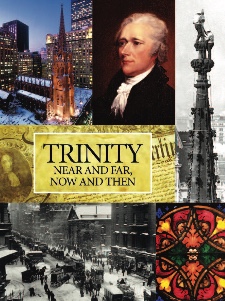
Trinity: Near and Far, Now and Then |
Reviewed by Richard J. Mammana
There are few parishes known more widely in the Anglican Communion than Trinity Church Wall Street — called the “Mother of Churches” in a 1973 parish history written by Clifford Phelps Morehouse of The Living Church. Since Trinity received its charter in 1697 from King William III, the church has been a center of parochial, diocesan, urban, national, and international Christian endeavor. This new parish history traces Trinity’s life from its beginnings in early New York to the aftermath of the September 11 terrorist attacks, when Trinity’s St. Paul’s Chapel became a major center for rescue work.
Under the skillful review of executive editor Linda Hanick, Trinity’s central place in myriad aspects of Episcopal Church life comes into clear view: the Revolutionary War, church art and architectural history, education, choral music, fluctuating real estate markets, the High Church and Low Church disputes of the 19th century, civil rights, urban outreach, and the eventual globalization of the Anglican Communion all receive brief but careful treatment.
A major strength of the book is the inclusion of eight “partner profiles,” interspersed throughout the chronological narratives — interviews with living individuals who have carried out work with Trinity’s support far beyond its walls: in Haiti, among rural and migrant communities in New York State, in Harlem, in South Africa, in Burundi, and in the aftermath of Hurricane Katrina. The authors are mindful in balancing the more recent life of the parish with an awareness of its past, too: there are brief profiles of all past rectors, a notice of “Who’s Who in the Churchyard” (most notably Alexander Hamilton), and important attention to the large number of mission chapels and chapels of ease opened by Trinity across the centuries.
The presentation of this parish history is lavish, on glossy paper with one or more pictures on each page. It even includes a pocket in the back cover with reproductions of historical documents from Trinity’s archival holdings: the deed Aaron Burr signed when he purchased three lots of land from Trinity; a ticket to visit the steeple (Trinity was the tallest building in New York from 1846 to 1890); a child’s letter to 9/11 firefighters and police who worked at St. Paul’s Chapel; several postcards; an invitation to the parish’s bicentennial celebrations in 1897; and the 1696 “Drift Whale Document” granting Trinity ownership of beached whales. With eight authors, almost two dozen other named contributors, and a magazine-like style, Trinity: Near and Far, Now and Then is a hybrid between a coffee-table book and an outsized issue of National Geographic.
The book is a fine walk through the past and modern life of a parish community that journalist Jon Meacham describes as “at once temporal and eternal, tangible and intangible, secular in setting yet sacred in mission.” Meacham adds in his introduction: “Perhaps no parish in the Anglican Communion is a more vivid example of the contrasts between the hectic pace of this world and the holy promise of the next than Trinity Wall Street, which stands still on eminent ground, devoted all these centuries distant to the work of the risen Lord.”
Richard J. Mammana is the archivist of the Living Church Foundation and a parishioner and vestry member at Trinity Church in New Haven, Connecticut.









